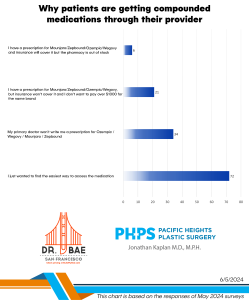
As more consumers research cosmetic surgery online and watch surgery on social media, there’s one thing they keep hearing. That their plastic surgeon won’t operate on them if their BMI (body mass index) is greater than 30. BMI refers to the “magic number” that takes into account your weight in kilograms and your height in centimeters.
BMI has its advantages in the sense that it doesn’t rely solely on your weight to determine if you’re high-risk for surgery. For example, being 300 pounds may sound obese (and increase your risk of wound-healing issues after surgery), but if you’re Shaquille O’Neal, that number may be reasonable since you’re over 7 feet tall. That’s why doctors use BMI instead of just weight to assess your level of obesity and subsequent surgical risk.
Why BMI isn’t enough
But at the end of the day, BMI is still just a number. What about the patient’s overall health? If a patient has a low BMI (good) but also has high blood pressure and diabetes (bad), they’re still high risk for an elective, cosmetic procedure. They could still have problems during surgery or problems with wound healing after surgery.
That’s why we take the whole patient into account when deciding whether they’re a candidate for surgery. Specifically, when it comes to patients that have had a lot of weight loss, they may still have a high BMI. But what are they supposed to do with all of the extra skin that’s left behind? If every doctor turns them down to have their excess skin removed, then it’s sort of bittersweet to lose all of that weight but still not be able to fit into smaller clothes because of the extra skin. And since they lost that extra weight, they probably also cured their high blood pressure and diabetes.
But we do have a limit
So while we may remove the extra skin and fat on someone with a high BMI, we still have to put safety first. That means we limit the amount of fat we remove during each surgical stage. We try to keep the liposuction and fat removal to a 5-liter limit.
The risk of removing too much fat during liposuction is a severe form of dehydration called hypovolemic shock. So the high-BMI patient must understand that while we’ll get them started on their journey (when other doctors may not), it may take several stages of surgery to reach their goal because of the 5-liter limit during each stage.
Take the patient above (and below) as an example. Her BMI is above 30 but there’s no question she benefitted from having her excess skin and fat removed during her tummy tuck procedure. Due to our fat removal limit, she will come back for a second stage to address her thighs.

Check out this video to hear my BMI soapbox!
Just to be clear, a patient with a lower BMI and no medical problems is definitely at a lower surgical risk that one with a high BMI. But if the high-BMI patient is healthy and without those other medical conditions (diabetes, high blood pressure), they can still go through surgery safely. It just may take more than one procedure.
If you want to check your BMI, click here. And if you want to check pricing on various body contouring (skin/fat removal) procedures from Dr. Kaplan, click here.
Click here for the original blog post written by Dr. Kaplan for BuildMyBod.




